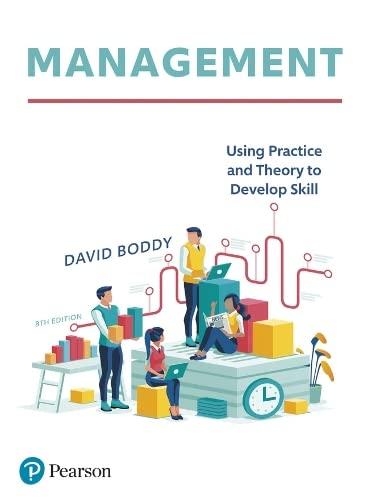Question
Knowledge Management (KM) will soon pervade business practices in the same way that eBusiness pervades commerce. Today a company's value centers on its intangible assets
Knowledge Management (KM) will soon pervade business practices in the same way that eBusiness pervades commerce. Today a company's value centers on its "intangible assets" as coined by Karl-Erik Sveiby, which pertains to the competencies, relationships, and information that exist virtually anywhere within a company, from the minds of employees, to back-end database files, to documented policies and procedures. KM technologies essentially capture these intangible assets and provide a context for their application and preservation within the business environment which strengthens organizational competitiveness and long-term growth potential. In fact, elements of KM are already manifested in many successful eBusiness practices such as electronic procurement where knowledge accelerates and bolsters the entire procurement process.
Lotus believes that there are five core technologies that underpin KM: Business Intelligence, Collaboration, Knowledge Transfer, Knowledge Discovery, and Expertise Location. Among these, Business Intelligence is growing with OLAP, Data Mining and other techniques for analyzing structured data; Collaboration is shifting to a blend of synchronous, asynchronous and community-focused tools; and Knowledge Transfer is quickly expanding into eLearning. Moreover, Knowledge Discovery and Expertise Location are emerging as new ways to access previously unattainable content and human expertise. Portals are the technological key players to these technologies. They bind them together and provide an entry to the knowledge that exists both within and beyond organizational boundaries. By providing this access to knowledge and a context for its use, these technologies ultimately deliver on the promise of KM.
Lotus and IBM have identified People, Places & Things as the three essential ingredients of an effective KM infrastructure. According to this concept, people, not facts, are the focal point of KM. People bring powerful insights and expertise to the business process and require places where they can create and act on knowledge, and things to help them meet their business goals.
People represent the employees, customers, partners, experts, and other individuals who are central to an organization's business success. KM technologies provide them with the context and tools for effective interaction. These technologies also offer features that identify people in terms of who they know, what they know, and how proficient they are at a given task.
Places are the virtual workspaces in which people come together to brainstorm, learn, and interact. KM technologies provide these workspaces and equip them with structured content, learning tools, and communications technologies, so that users can make asynchronous and real-time connections.
Things include the data, information and processes that are created, captured, classified, and shared across an organization. KM enables the end user to access and apply these things to their business goals.
The Lotus K-station Portal is the first product to emerge from the development effort code named "Raven" which provides tools to serve the collaborative needs of business communities. Likewise, IBM provides a series of portal tools, including the IBM Enterprise Information Portal (EIP) and the IBM Websphere Portal Server (WPS) to serve the needs of enterprises. These IBM and Lotus products crossintegrate so customers can build robust, scalable, and complete portal solutions based on their unique organizational needs.
"Raven" is the project code-name for an integrated collection of KM technologies that include, a knowledge portal for the management of personal, community information and discovery tools for content tracking and analysis, user profiling, and expertise location. Moreover, K-station is the first product to emerge from the Ravendevelopment effort; it provides a portal, or single point of entry, through which end users and communities can conduct their business tasks. The product enables end users to organize their work by community, interest, task, or job focus, and provides powerful capabilities for team collaboration. Discovery Server is the second product to emerge from the Raven effort, providing discovery tools that categorize content and organizational expertise into browsable and searchable catalogs. Both products are fully integrated and can be used in unison or as individual solutions.
When a KM infrastructure is properly assembled, People, Places & Things are combined into a context that delivers business value. The Request for Proposal (RFP) process is a good example of a team-oriented business challenge that is well served by KM technologies. In this scenario, an end user starts by creating a "RFP place," which is a Unit of Context for accomplishing a business task. Unlike a file directory, this RFP place is a virtual workspace where the document can be created, reviewed, and ultimately accessed for future use. The lead person in this case uses the system to identify experts and invite team members to the newly created RFP workspace.
In order to survive, companies must harness and apply their inherent competencies, relationships, and information. The means toward this end is KM, a discipline that Lotus and IBM define as the interaction of People, Places & Things in a meaningful context that discovers and preserves value. By understanding KM in this way and providing the unifying technologies for community and enterprise-wide support, Lotus and IBM are helping their customers leverage intangible assets and thrive in the information age.
[Source: A Lotus Development Corporation White Paper, September 2000]
QUESTIONS:
1.With reference to the case study, how can Knowledge Discovery facilitate knowledge reuse for improved competitive edge at the Lotus?
2.Describe the crucial role of the data mining and OLAP for business intelligence at the IBM?
3.How can Communities of Practice (CoPs) benefit from the "Raven" project?
4.Explain two IT security challenges that need to be considered when working in a virtual workspace.?
Step by Step Solution
There are 3 Steps involved in it
Step: 1

Get Instant Access to Expert-Tailored Solutions
See step-by-step solutions with expert insights and AI powered tools for academic success
Step: 2

Step: 3

Ace Your Homework with AI
Get the answers you need in no time with our AI-driven, step-by-step assistance
Get Started


